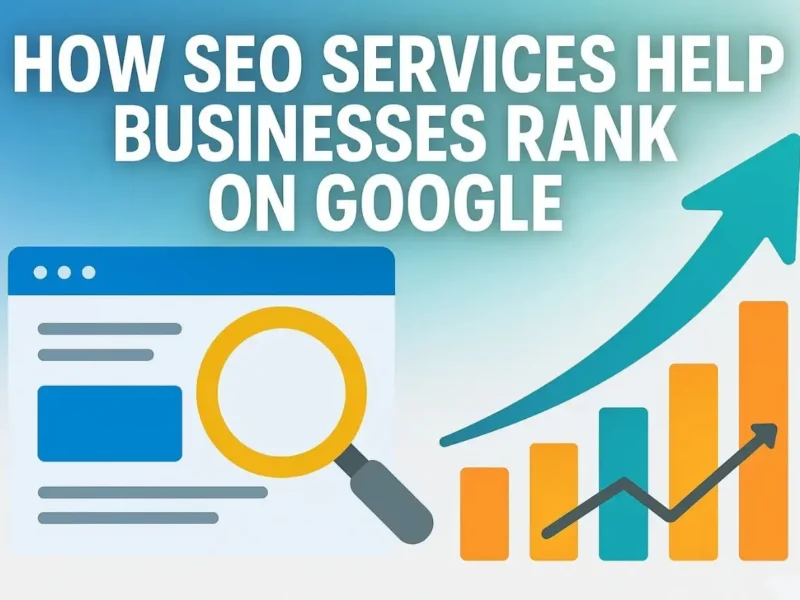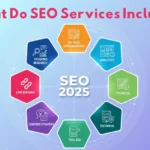If you’ve ever asked yourself how SEO services help businesses rank, you already know the answer isn’t “sprinkle keywords and hope.” Ranking is the byproduct of dozens of decisions executed well: building pages that answer real questions, making your site easy to crawl and fast to load, organizing topics into authority‑building clusters, and earning references from credible sources. When these pieces run in a steady operating rhythm, visibility compounds. When they don’t, you chase quick fixes while competitors pass you.
This guide is a clear, hands‑on explanation of how SEO services help businesses rank and keep ranking as algorithms evolve and user expectations rise. You’ll learn the exact work a credible provider performs, what to expect in the first 90 days, how to measure success, and how to choose a partner you can trust.
What you’ll get:
- A practical model for how SEO services help businesses rank (and why the order of operations matters)
- A complete breakdown of technical, on‑page, content, local, and off‑site work that moves the needle
- KPIs, dashboards, and a CFO‑friendly ROI framework
- Pricing models, vendor questions, and red flags
- A 90‑day roadmap from audit to outcomes
Let’s turn search from a mystery into a system.
The Simple Model: How SEO Services Help Businesses Rank
Before we dive deep, here’s the short version of how SEO services help businesses rank across four pillars:
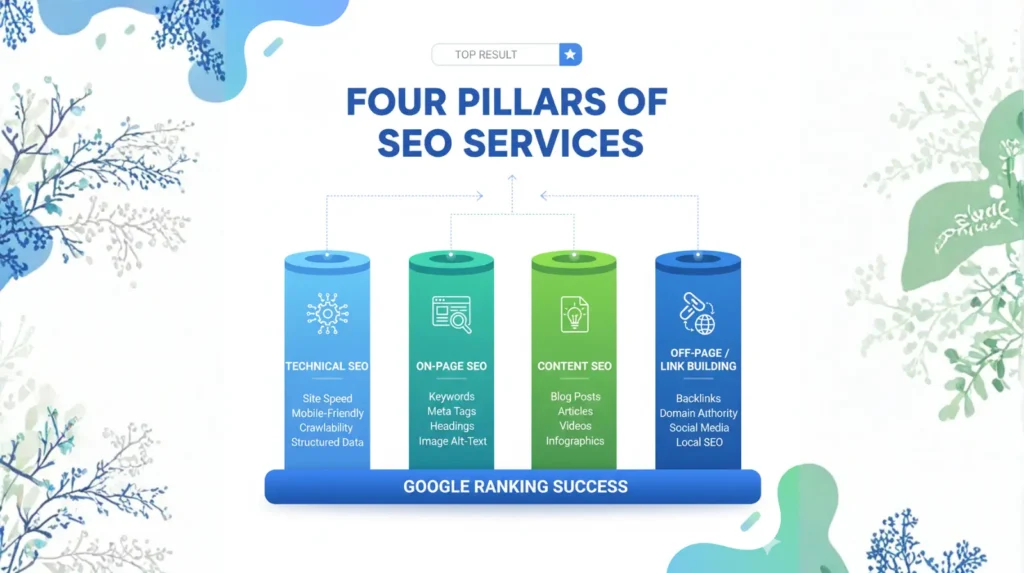
Make the site discoverable and fast
- Crawlers can reach and index the right pages, templates are sturdy, Core Web Vitals pass on real devices, and content renders cleanly.
Align pages with searcher intent
- Each page targets a clear question or job‑to‑be‑done, is the easiest to understand, and makes action obvious and safe.
Build topical authority
- Organized hubs and supporting articles show depth and practical experience, reinforced by internal links and structured data.
Earn and maintain trust
- Real reviews, reputable mentions, accurate profiles, and transparent policies demonstrate reliability on and off your site.
SEO services string these together into a weekly operating rhythm. That cadence is how SEO services help businesses rank and stay ranked even as the landscape shifts.
Strategy First: Tie Ranking to Revenue
If you don’t anchor search work to outcomes, you’ll drown in tactics. Here’s how seasoned teams kick off.
Discovery and baselines (week 1–2)
- Stakeholder interviews: marketing, sales, product, support
- Metrics that matter: online revenue, qualified leads, bookings, calls by channel
- Data checks: Search Console verified, analytics goals/events configured, clean UTM usage
- Baselines: impressions, clicks, CTR, rankings by topic and intent, conversions from organic
Why this matters: When you understand the starting line, you can explain how SEO services help businesses rank with timelines and probabilities not guesses.
Audience and intent mapping (week 2–3)
- Customers’ jobs‑to‑be‑done and pain points
- Intent segmentation: informational, commercial, transactional, navigational
- Topic cluster design: pillars (hub pages) and clusters (supporting articles) that address the full journey
Roadmap and resourcing (week 3–4)
- 90‑day plan by sprint: technical fixes, content, local, PR
- RACI: who writes, reviews, deploys, measures
- Forecast ranges: conservative/base/optimistic tied to activities
A credible provider can show, in week one, how SEO services help businesses rank within your constraints what will be shipped and when.
Technical SEO: Build a Crawlable, Fast, Structured Site
Even the best content underperforms on a site that’s slow, confusing, or invisible to crawlers. Technical excellence is the foundation of how SEO services help businesses rank.
Crawlability and indexation
- robots.txt: allow important sections; block only private/staging areas
- Canonicals: self‑referencing on canonical pages; avoid conflicts with hreflang and pagination
- Meta robots: use index/noindex and follow/nofollow deliberately
- XML sitemaps: include only indexable URLs; split by type and size; keep fresh
Facets, parameters, and pagination
- Parameter control: prevent infinite combinations from bloating crawl; rely on canonicalization or meta robots for non‑canonical filters
- Pagination: sensible page‑to‑page linking; surface the best items early; ensure crawlers can reach deep content without traps
Information architecture and internal linking
- Logical hierarchy: home → category → subcategory → detail
- Breadcrumbs with schema; consistent URL patterns
- Contextual links: hubs to clusters, clusters back to hubs, using descriptive anchors
Page experience and Core Web Vitals (field data first)
- LCP: compress and prioritize hero images; reduce server response times; defer non‑critical JS
- INP: break up long tasks; avoid heavy third‑party scripts; prioritize interactivity
- CLS: reserve space for media; preload fonts; avoid layout‑shifting banners and popups
Rendering and JavaScript
- Ensure critical content and links are available without user interaction
- Verify parity between “view source” and rendered DOM on key templates
- Use server‑side rendering or tested hydration patterns where appropriate
Structured data and entities
- JSON‑LD for Article, Product, FAQ, HowTo, Organization, BreadcrumbList validated with Rich Results Test
- Consistent entity naming and organization details across site and profiles
This is the technical core of how SEO services help businesses rank: make every important page fast, crawlable, indexable, and machine‑readable.
On‑Page Optimization: Match Pages to Real Queries
On‑page work turns broad topics into specific, helpful pages. This phase of how SEO services help businesses rank has three goals: answer clearly, guide action, and earn trust.
Keyword‑to‑intent mapping
- “One page, one main promise” with 2–4 closely related questions
- Titles and H1s that reflect natural language, not awkward stuffing
- H2s/H3s that mirror search questions; a concise answer (40–60 words) near the top for snippet eligibility
Internal linking and anchor strategy
- Link from topically related pages; avoid orphans
- Use descriptive anchors that match the destination’s topic
- Add a table of contents and jump links on long guides
Media, accessibility, and UX
- Original images, diagrams, and tables; descriptive alt text
- Captions and transcripts for video; clear contrast and focus states
- Obvious CTAs; fast, friction‑free forms; avoid intrusive interstitials
Trust and expertise cues
- Author bylines with credentials; last‑updated dates on evergreen content
- References to reputable sources; transparent policies; easy contact options
These on‑page practices are how SEO services help businesses rank for competitive terms without resorting to tricks.
Content Strategy: Build Topical Authority
Authority is earned by covering a topic with depth, clarity, and first‑hand experience not by publishing every day. Here’s how content work fits into how SEO services help businesses rank.
Topical mapping and cadence
- Choose 3–5 core themes tied to business value
- For each theme: 1 pillar hub + 6–12 clusters (mixing informational and commercial queries)
- Realistic cadence (e.g., two clusters per week; one pillar per month)
Briefs and subject‑matter input
- Each brief includes: search intent, success criteria, H2/H3 outline, required examples/screenshots/data, internal links, and schema suggestions
- Interview internal experts and customers to gather first‑hand insights
Production and quality control
- Draft for clarity and usefulness, not word count
- Edit for accuracy, originality, and scannability; run plagiarism and fact checks
- Add unique visuals; embed tools or checklists when helpful
- Final on‑page optimization: title/meta, schema, internal links, accessibility
Refresh and consolidate
- Quarterly review: update stats and examples; consolidate overlapping content; redirect retired pages to the best version; update anchors accordingly
This is one of the most impactful ways how SEO services help businesses rank: fewer, better pieces that build authority and convert.
Local SEO: Win “Near Me” and Map Pack
If you operate physical locations or serve local areas, map and profile visibility is direct revenue. Local work is a specific, high‑ROI slice of how SEO services help businesses rank.
Google Business Profile (GBP)
- Complete profiles: primary/secondary categories; attributes; services
- High‑quality photos/videos; brand‑consistent cover image
- Posts (updates/offers/events); Q&A monitoring and responses
- Accurate hours, including holidays; messaging when appropriate
Citations and consistency
- Name, address, phone consistent across directories
- Ongoing cleanup to remove duplicates and fix errors
- Niche citations in your industry/clusters
Reviews and responses
- Review generation built into the customer journey
- Empathetic, prompt replies; escalate sensitive issues offline
- Showcase selected reviews on location pages with schema
Location pages
- Unique content per location: staff intros, services, parking, neighborhoods served
- Embedded map, click‑to‑call, localized FAQs, Local Business schema
A robust local program is a clear demonstration of how SEO services help businesses rank where it matters: the moment someone’s ready to call or visit.
E‑commerce SEO: Category and Product Pages That Convert
Stores require specialized patterns. Getting these right is another concrete way how SEO services help businesses rank and drive revenue.
Category and facet strategy
- Canonicalization and indexation rules for filters; avoid duplicate near‑identical pages
- Helpful category copy: buying tips, sub‑category links, top FAQs
- Internal links to best‑sellers and related collections
Product detail pages (PDPs)
- Unique titles, bullets, and descriptions; avoid verbatim manufacturer copy
- Rich media: original images, 360s, videos, size guides, comparison tables
- Reviews and FAQs with schema; back‑in‑stock and waitlist UX
- Structured data: Product, Offer, Aggregate Rating, Review, FAQ Page
Pagination and crawl budget
- Smart pagination; surface best products early; prevent deep crawl traps
- Link to important deeper items; highlight featured products
Shopping surfaces and feeds
- Clean product feeds with accurate availability and pricing
- Merchant profiles aligned with site details
When stores ask how SEO services help businesses rank, the proof is in clean categories, differentiated PDPs, and filter rules that prevent crawl chaos.
International SEO: Right Content, Right Country
Expansion needs more than translation. Getting structure and signals right is a specialized part of how SEO services help businesses rank across regions.
Strategy and structure
- Choose ccTLDs, subdomains, or subfolders based on resources and authority
- Prioritize content by market demand (not every locale needs every page)
- Local competitor analysis and cultural nuance
hreflang and localization
- Correct hreflang implementation (language‑region pairs); include x‑default where needed
- Professional translation and localization of examples, currency, and units
- Canonicalization within each locale; avoid cross‑market duplication
Monitoring and governance
- Search Console per market; index coverage and performance monitoring
- Prevent cross‑market cannibalization; keep naming consistent
This structural precision is how SEO services help businesses rank globally without stepping on their own toes.
Digital PR and Link Earning: Authority Beyond Your Site
Not all links are equal. The best programs earn relevant mentions from real publications your audience reads. Off‑site work reinforces how SEO services help businesses rank sustainably.
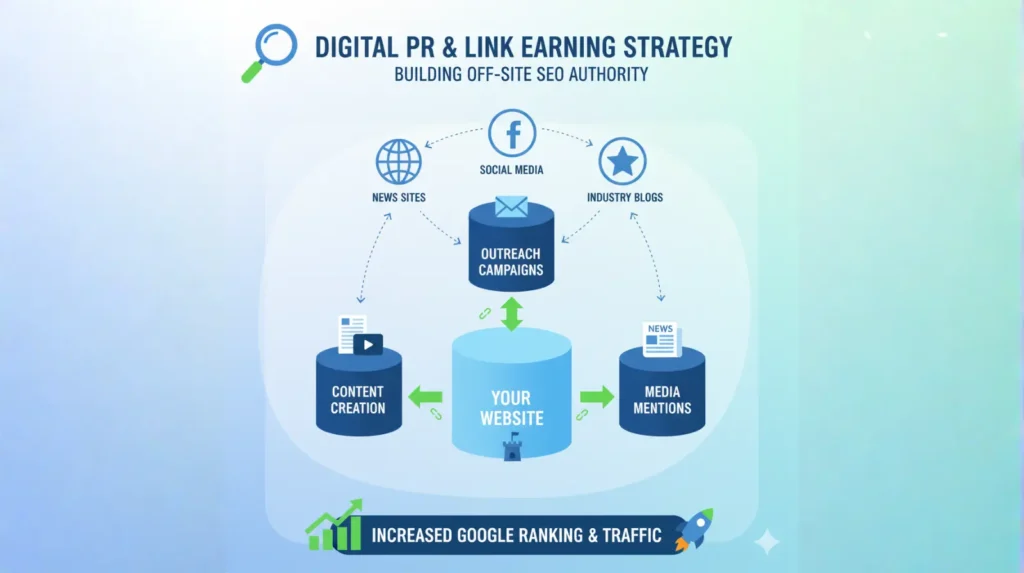
Campaign types that work
- Data stories: proprietary research or thoughtful analyses of public data
- Expert commentary: quotable insights on timely topics
- Tools and calculators: useful assets others want to reference
- Case stories: detailed “how we did X” with numbers and steps
Prospecting and outreach
- Build journalist/editor lists by vertical and beat; personalize pitches
- Provide assets: charts, quotes, methodology
- Follow‑up once; maintain respectful cadence
Measurement and quality control
- Track referring domains, traffic from coverage, and assisted conversions
- Evaluate placement context and site quality; avoid paid link schemes
- Maintain a campaign calendar that aligns with content releases
When people ask how SEO services help businesses rank beyond on‑site work, these reputation signals are the answer.
Analytics, KPIs, and Reporting: From Numbers to Decisions
If you can’t measure it, you can’t improve it. Rigorous reporting is a cornerstone of how SEO services help businesses rank with accountability.
Clean setup
- Search Console: domain properties; sitemap submissions; enhancements monitoring
- Analytics: conversions/events; e‑commerce tracking where relevant
- Dashboards (Looker Studio/BI): topics, page groups, intent, Core Web Vitals, index coverage
KPIs that matter
- Leading indicators: impressions by topic; ranking distribution (Top 3/10/50); CWV pass rates; index coverage
- Lagging indicators: clicks, sessions, CTR; conversions and revenue from organic; assisted conversions
- Quality signals: author pages, citations, last‑updated cadence; reviews and brand mentions
Testing and iteration
- Title/meta experiments by template (avoid thrashing unique URLs)
- Internal link placement tests and anchor clarity
- Content refresh impact: before/after comparisons on target pages
A weekly habit of reviewing a one‑page scorecard and making one decision from it is how SEO services help businesses rank and keep improving.
Migrations and Redesigns: Protect What You’ve Earned
Site changes are where many teams lose years of progress unless handled right. A migration runbook is part of how SEO services help businesses rank through change.
Pre‑launch
- URL mapping: one‑to‑one redirects for every legacy URL; test coverage
- Content parity: preserve critical content, headers, schema; document exceptions
- Technical parity: robots, canonicals, sitemaps, hreflang, analytics; Core Web Vitals checks
- Staging crawl; rendered vs. source comparisons; fix gaps
Launch day
- Remove staging noindex/disallow
- Push redirects; submit new sitemaps
- Live crawl; prioritize 404 and redirect chain fixes
Post‑launch
- Monitor Search Console coverage and top page performance; triage regressions
- Fix quickly; document changes; communicate with stakeholders
This discipline is another unglamorous but vital way how SEO services help businesses rank without interruption.
Governance and QA: Make Quality a Habit
Sustained ranking comes from good habits. Governance gives you those habits.
Pre‑flight checklists
- Monitor Search Console coverage and top page performance; triage regressions
- Fix quickly; document changes; communicate with stakeholders
This discipline is another unglamorous but vital way how SEO services help businesses rank without interruption.
Governance and QA: Make Quality a Habit
Sustained ranking comes from good habits. Governance gives you those habits.
Pre‑flight checklists
- Content: brief alignment, on‑page elements, schema, internal links, accessibility
- Technical: robots/canonicals, sitemaps, hreflang, CWV checks, analytics tags
Change logs and releases
- Document template/navigation changes and major content updates
- Annotate analytics for big launches and campaigns
Operating rhythm
- Weekly standup: one decision from the dashboard; one fix shipped; one piece moved forward
- Monthly review: wins, misses, upcoming priorities, risks
This is the “boring work” that explains how SEO services help businesses rank quarter after quarter.
Pricing Models, Scopes, and Red Flags
Understanding pricing and scope helps you buy with confidence.
Common models
- Retainer: ongoing strategy, execution, and reporting; compounding work
- Project: audits, migrations, or specific sprints; tight scope and timeline
- Hybrid: base retainer + defined quarterly projects
What a useful scope includes
- Objectives tied to business outcomes
- Deliverables by sprint/month (audits, briefs, pages, fixes, PR plays)
- Access requirements (CMS, analytics, Search Console, code repos)
- SLAs for approvals and content reviews
- Success metrics and reporting cadence
Red flags
- Guaranteed rankings
- Vague “link packages” or domain rating promises
- Reporting that avoids conversions/revenue
A clear scope makes it obvious how SEO services help businesses rank and how work becomes outcomes.
Vendor Selection: Questions That Separate Signal from Noise
- Walk us through a recent program: goals, constraints, work shipped, measured outcomes.
- What will you deliver in the first 90 days? Show the calendar.
- How do you prioritize technical, content, and PR within our budget?
- Who will attend weekly meetings? What’s their experience in our industry?
- How do you measure quality beyond rankings (expertise, engagement, conversions)?
- How do you manage migrations to avoid traffic loss?
- If priorities shift, how do you reallocate and communicate impact?
If a provider can answer these clearly with artifacts you’ll know how SEO services help businesses rank in your environment.
A 90‑Day Roadmap You Can Copy
This plan is realistic for most teams and shows how SEO services help businesses rank in one quarter.
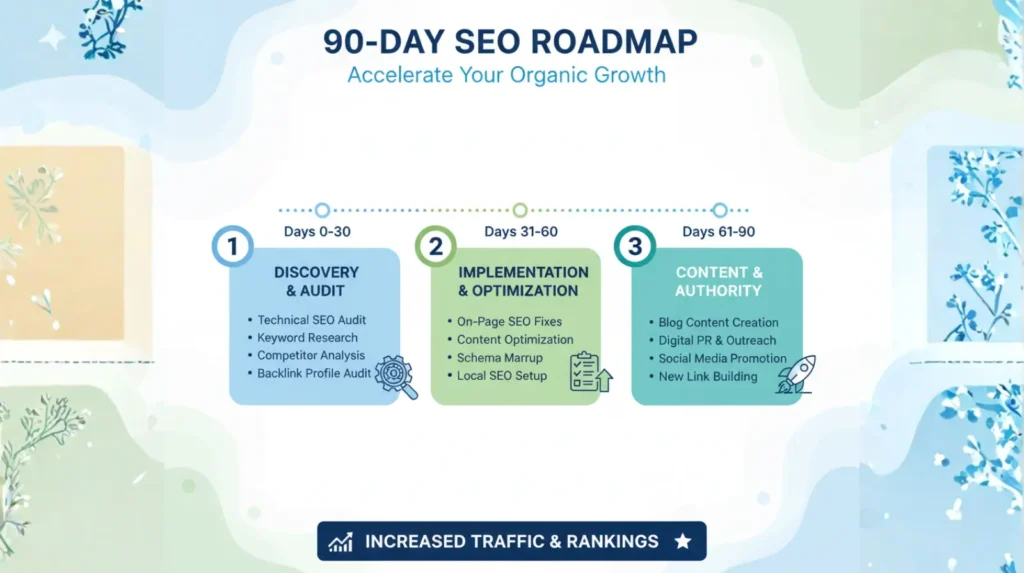
Days 1–30 Foundation
- Discovery; KPI alignment; baselines; dashboards live
- Technical crawl; implement “fix fast” items (indexation leaks, critical CWV deficits)
- Topic map for two core themes; 6–10 content briefs
- Optimize underperforming titles/meta on high‑impression pages
Days 31–60 Execution
- Publish 4–6 cluster articles and one pillar; add schema and internal links
- Resolve top technical items by template; measure field data improvements
- Launch one digital PR play (data story or expert commentary)
- Local: audit and improve profiles; update top location pages
Days 61–90 Scale and refine
- Publish additional clusters; refresh one high‑potential legacy asset
- Clear remaining technical priorities; clean parameter handling and sitemaps
- PR follow‑ups; pitch 10–20 targeted outlets; track coverage
- Review KPIs; document what worked; plan next quarter’s scope
This cadence is the living blueprint for how SEO services help businesses rank and turn rankings into revenue.
ROI Modeling: Show the Math
Leaders need numbers. Here’s a simple framework to quantify how SEO services help businesses rank profitably.
Efficiency
- Hours saved from better processes (briefs, automation, QA) × fully loaded hourly rate
- Faster technical triage from prioritization and templates
Effectiveness
- Incremental organic clicks × site conversion rate × AOV/margin
- CTR lift from title/meta tests × impressions × conversion rate
Risk reduction
- Avoided revenue loss from migrations or CWV regressions fixed ahead of peak season
Program costs
- Fees + integration + content production + contingency
Net ROI = (Efficiency + Effectiveness + Risk reduction − Program costs) ÷ Program costs
Update quarterly with observed data. This transparency is another way how SEO services help businesses rank with trust from finance.
Case Snapshots (Anonymized)
B2B software (topical authority + CWV)
- Challenge: Fragmented content, weak authority
- Work: Two pillars + 12 clusters; internal link graph; schema; CWV fixes
- Results (90 days): +36% clicks on target topics, 6 snippet wins, CWV pass rate from 58% to 91%
DTC retailer (category/PDP enrichment)
- Challenge: Thin category pages; slow LCP
- Work: Category copy and FAQs; PDP enrichment with reviews/FAQs; image optimization
- Results: +23% organic revenue QoQ, −29% LCP, 10 new rich‑results slots
Local multi‑location services (GBP + location pages)
- Challenge: Inconsistent profiles; weak local content
- Work: GBP overhaul, citation cleanup, location page revamp, review generation
- Results: +45% calls from profiles, +27% map pack visibility across 40 locations
These are typical outcomes when the full stack of how SEO services help businesses rank is executed with discipline.
Conclusion: Turn Ranking Into a Weekly Habit
By now, the mechanics of how SEO services help businesses rank should feel clear and achievable: fix what blocks discovery, publish fewer‑but‑better pages in organized clusters, earn credible mentions, and make decisions from a simple dashboard every week. Do this for one quarter and you’ll notice the shift: steadier impressions, higher CTR, more conversions from organic, and fewer fire drills.
Your next steps:
- Write two objectives for the next 90 days (one technical, one content)
- Verify analytics and Search Console; build a simple scorecard
- Fix the top three technical blockers by template
- Publish four helpful pieces in one topic cluster with schema and internal links
- Optimize your Google Business Profile and top location/service pages if relevant
- Tie one weekly decision to your dashboard and log the outcome
That rhythm more than any secret hack is how SEO services help businesses rank and keep winning as the web evolves.
FAQs
What’s the fastest way to understand how SEO services help businesses rank?
Look for a 90‑day plan that combines quick technical wins, 6–10 helpful articles in two topical hubs, and clean reporting. You should see movement in impressions and CTR within weeks, and conversions beginning 6–12 weeks in.
How do technical improvements factor into how SEO services help businesses rank?
They’re foundational. Fixing crawl/indexation, Core Web Vitals, and structured data enables pages to be discovered, understood, and recommended. Without that, even great content underperforms.
Does content still matter in how SEO services help businesses rank?
More than ever. Organized, experience‑rich content that answers real questions builds topical authority, wins snippets, and converts. Quality beats volume.
Where does local fit into how SEO services help businesses rank?
For any business with locations or service areas, local profiles and location pages are direct ranking (and revenue) drivers. Accurate data and real reviews are essential.
How do links and PR show up in how SEO services help businesses rank?
Earned mentions from relevant publications build credibility and can accelerate rankings for competitive topics. Quality and relevance matter far more than raw counts.
What dashboards prove how SEO services help businesses rank?
A one‑page scorecard with impressions/ranking distribution (by topic), CTR, conversions from organic, Core Web Vitals pass rates, index coverage, and a log of changes shipped.
How do I evaluate a firm’s plan for how SEO services help businesses rank?
Ask for a week‑by‑week calendar of deliverables for 90 days, the KPIs they’ll move, and examples of previous artifacts (briefs, dashboards, migration runbooks). Avoid vague promises.




